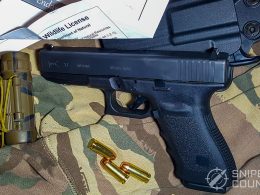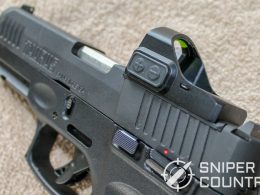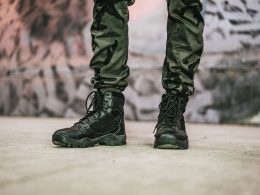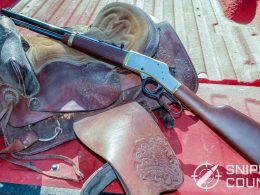In this Article:
I recently was able to snag a used SIG Sauer P226 from my friend Duane’s gun case to review. The gun is chambered in .40 S&W and is in pretty decent shape, considering that it was shot and carried a lot. The P226 is one of those classic guns that has a great reputation. It just seems to always work when needed and is built, to overuse a quote, like an M1 Abrams tank. Needless to say, they are popular, whether in .40 S&W or the other calibers they are offered in (.22 LR, .357 Sig and 9mm). We’ll look at the background of the gun and its variations, then we’ll continue with specs and features. We’ll take a quick look at the .40 S&W cartridge and talk about shooting the gun, and then we’ll finish it up. Let’s get started…
A Little Background
The P226 was designed and produced to take part in the U.S. Army’s 1984 XM9 Service Pistol Trials. The gun was based on the SIG Sauer P220, a single-stack service pistol made as a collaboration between two companies: the Swiss-based Schweizerische Industrie Gesellschaft (SIG), and Germany’s J.P. Sauer & Sohn. The gun debuted in 1975. The P220 was, itself, a refinement of the Petter-Browning design used in the P210. The locked breech of the P220 differs from that of the P210 – it was developed by SIG Sauer and is proprietary. The P220 went on to become a very popular gun, especially among law enforcement agencies. So, it is no surprise that its stablemate, the P226, would be popular as well. This also includes its compact variation, the P229.
Enter the Browning BDA
The P220 was sold initially in the United States by Browning, as the Browning Double Action pistol (BDA). It was the first SIG Sauer pistol sold in the U.S. It sold pretty well, and eventually it was imported and sold under the SIG banner as the SIG Sauer P226. I remember when the BDA pistol came out. It didn’t fit with the guns that Browning was selling at the time, like their rifles and well-known shotguns. The Hi Power was the mainline handgun that they sold, so when a very modern-looking double/single action pistol hit the shelves with the Browning logo on it, many shooters took notice. It looked very substantial, a quality item. The gun was popular and received mostly good reviews. It filled a niche in the market for a double-action/single action 9mm gun that was very well-built and reliable. This was at a time when some of the other “wonder nines†were of dubious quality in terms of materials and workmanship. But, Browning…who could argue with that name?
SIG Enters the Military Trials
The pistol trials of 1984 were held by the U.S. Army to replace the venerable 1911 and other handguns in the various service branch’s arsenals. It’s interesting to note that only two guns successfully completed the rigorous trials – the eventual winner, the Beretta P92F and the SIG Sauer P226. (I’d forgotten that the SIG was a finalist – that says a lot for the gun, if not for my memory). According to the Government Accounting Office, the SIG was actually chosen to be the 1911’s successor as it was the cheaper of the two guns and had passed all the trials, but the package price was a bit higher than that of the Beretta. The “package price†included things like magazines and spare parts, in case you were wondering. Consequently, the Beretta was chosen.
The Navy SEALs and a few other units did adopt the P226 (as the P226 MK25 with special corrosion resistance, in the SEAL’s case). The gun was imported by Saco Defense for the military, but Interarms took over when the gun was offered for civilian consumption. Eventually, SIGARMS became SIG Sauer in the U.S., and that’s what it is now. This is the company that imports the guns that we buy. SIG Sauer guns are made today in two places. The European location is in Eckenförde, Germany by SIG Sauer GMBH, and in the U.S. at the Newington, New Hampshire plant by SIG Sauer, Inc. (Exeter, NH is stamped on the slide).
A Little Speculation…
Just think…the way I read it, if P226 spare parts and magazines had been a bit cheaper, the military would probably have adopted that gun instead of the Beretta. Who knows where that might have led? Our military just adopted a variation of a SIG P320 a couple of years ago (M17/M18) …would that have happened if they already had the 226 in their inventories? Even though one of the requirements of the newly-adopted pistol was modularity, maybe that wouldn’t have been an issue if the 226 was in service. One wonders about such things, since the P226 is built so well and has such a great reputation. Anyway, I was just wondering. It gives one pause to think of things that might have been.
BONUS OFFER: Get your free shooting range targets to print at home!
Get your free targets to print at home!
One Variation: A Little Off the Top, Please…
If the P226 is too large for you or is too difficult to conceal, there is an alternative: the P229. This is a compact version of the larger gun that was designed for either duty or concealed carry use (Read also: CCW Insurance Comparison). The P229 slide is milled from solid steel, while the original (9mm only) P226’s slide was stamped. The milled slide is now used for all 226 models to handle the higher .40 S&W/.357 Sig/9mm pressures. Here’s what the P229 looks like, with the P226 shown below it for comparison:
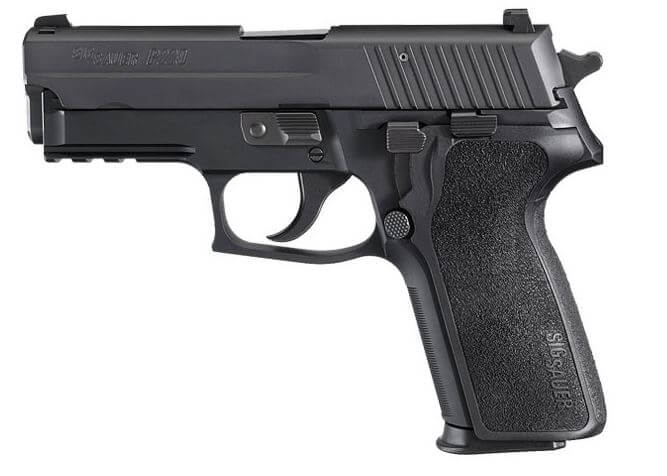
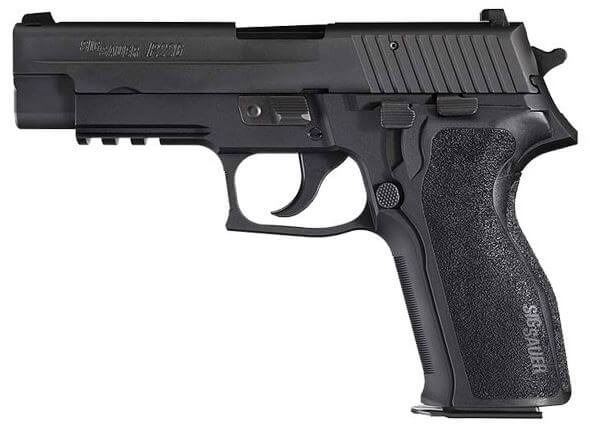
The P229 was the first pistol made that chambered the .357 Sig round. A simple barrel swap and the .40 S&W round could be shot, as both rounds use the same magazine. This also works in reverse – a .40 caliber P226 or P229 can fire the .357 Sig round with the addition of a replacement barrel in that caliber. (A stiffer recoil spring may also be needed – that would depend on the gun and the caliber you’re changing to. The .357 Sig needs a stiffer spring than the .40 requires). A visit to SIG’s website will reveal several variations of both the P226 and the P229, from single-action-only to optics-equipped guns and others. Sig is VERY big into variations…their website reveals at least 9 P226 and 10 P229 variants.
Specs
Let’s look at some specs on the P226…
| Caliber: | .40 S&W (also available in .22 LR, 9mm and .357 Sig) |
| Length: | 7.7 inches |
| Height: | 5.5 inches |
| Width: | 1.5 inches |
| Weight: | 34 ounces |
| Capacity: | 12 + 1 rounds |
| Barrel Length: | 4.4 inches |
| Sight Radius: | 6.3 inches |
| Trigger: | DA/SA, SAO, DAK (DA/SA is the only one I saw listed on the website) |
| Finish: | Nitron |
| Grips: | Textured Polymer (replaceable) |
| Sights: | SIGLIGHT night sights |
| Safeties: | Frame-mounted decocker, (DA/SA only); firing pin block (all models); thumb safety (SAO) |
| Slide: | Milled from solid steel block |
Popular Articles
What’s A DAK? Quick Answer – Two Trigger Reset Points…
We can’t really talk about the SIG P226/229 specifications without at least mentioning the DAK trigger system. The gun I borrowed and shot that you are seeing photos of uses this kind of system. A note: SIG only shows the DA/SA version of the P226 on its website now, but you may run into a DAK version if you’re looking at used pistols, like the one we have here.
This is one variation of the traditional double/single action trigger system. It is called the DAK (Double Action Kellermann, after the German engineer who invented it) trigger system. This system was developed in order to modify the long, harder first double-action trigger pull and the shorter, lighter single-action pulls…in theory. This is accomplished by the DAK trigger pull having two reset points and two distinct pull weights, not one reset point like normal DA/SA, single-action or striker-fired guns. So, you hear and feel two “clicks†as you release the trigger to its fully-forward position.
The way it was designed to work is like this… If you are wanting a volume of quick fire (several shots quickly) or have short-stroked the trigger in the heat of the moment, you fire from the closest, first reset point that requires an 8-pound pull. This first reset point is about halfway out, as you let the trigger come back forward, as it looked when I shot it. If you need to shoot with a bit more precision, you would let the trigger reset to its outermost point. This nets you a 6.5-pound pull, which theoretically aids in accuracy due to its lighter weight. But… it uses a full-length reset with the trigger all the way forward which may negate some of the anticipated accuracy (like any other DA trigger). SIG itself recommends that shooters train to fire from the 6.5-pound, fully-forward reset point but some agencies have trained their personnel to use the 8-pound, quicker-shots-lots-of-lead-downrange pull. The Secret Service had, in the past, procured P229s with the DAK trigger, along with other organizations and police departments. Some of these agencies had trained their personnel to fire from the closer 8-pound reset point which is contrary to the way SIG recommended they be trained. One fairly big benefit of the DAK trigger is its double-strike capability. This allows you to pull the trigger again on a primer that didn’t go off the first time without having to rack the slide. I have some striker-fired guns that utilize this feature – I like it. Lastly, since the hammer follows the slide forward and is down after racking the slide, a decocking lever is not needed. This could surely be a benefit for those who forget to lower the hammer on a typical DA/SA pistol using the decocking lever. They may have an accidental discharge as a result of trying to lower the hammer manually and having it slip. (Remember, some of the early DA/SA 9mms didn’t have the safety mechanisms built into them that more modern guns utilize). This is not a common occurrence, but it has happened. The DAK-system-hammer is automatically down after racking the slide or firing the gun – only the pull weights and reset point(s) of the trigger differ.
How Can I Tell at A Glance If My SIG Uses A DAK System?
That’s pretty easy, but first, let’s talk about the three main trigger systems that SIG has used over the years with the 226. The most common is the DA/SA system that they advertise on their website. This gun will have a decocker lever and a hammer with a spur:
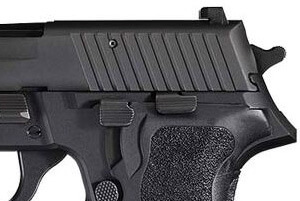
The second variation is the single action only system, like that of a 1911. You carry the gun cocked and locked:
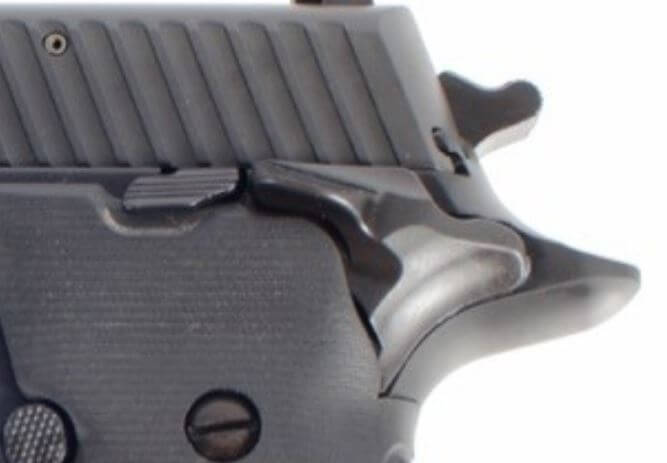
Notice the thumb safety and the spurred hammer. The third system is our pistol’s mechanism, the DAK. Notice no decocker lever and the rounded, spur-less hammer. THAT is how you tell if the 226 (or 229) you’re looking at will have the two reset points provided by engineer Harold Kellermann – the DAK system:
No decocker lever or hammer spur:
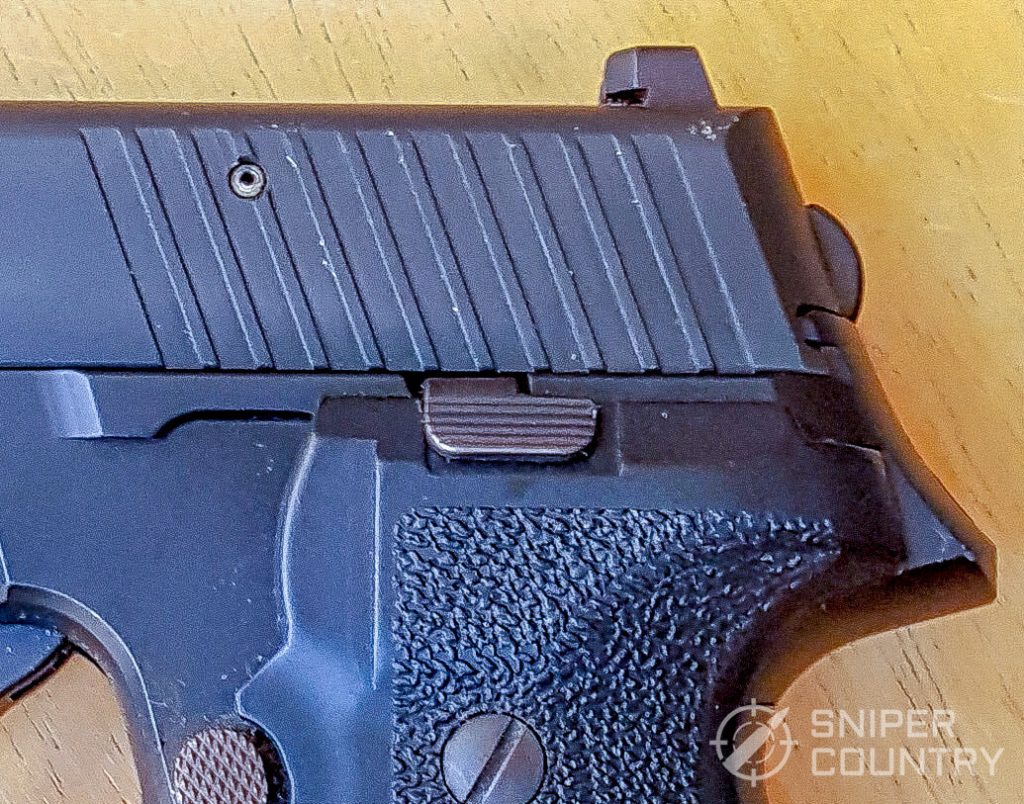
So… Who Uses the Sig P226/229?
Or, to put it differently, which agencies DON’T use it? OK, just kidding, but I tried to look up the various agencies that use one or the other gun. There isn’t room here to list them. From the Navy SEALs to the Secret Service to several State Police agencies to the Texas Rangers to foreign military units…these guns are extremely popular with military and law enforcement agencies around the world. As I stated above, there are many variations to choose from so that you can find just the right one for you…or your country’s army. Our Navy’s SEALs really helped cement the SIG P226’s reputation when they adopted it, with other units following their lead. The guns simply work and are built tough. Chambered for a barn-burner round like the .357 Sig, these handguns become truly awesome at whatever purpose they are used for. Our own state police use the double-stack, DA/SA P227 in .45 ACP and do very well with it. It’s basically a P226 chambered for the larger caliber. So… that’s one reason why they’re so popular…many agencies use them and trust them.
Features
The P226 is made from steel and aluminum. Stainless for the slide and anodized aluminum alloy for the frame. This makes for one tough gun, but there are other reasons to own one. Here are some photos I took of the particular P226 I shot and some of its features…
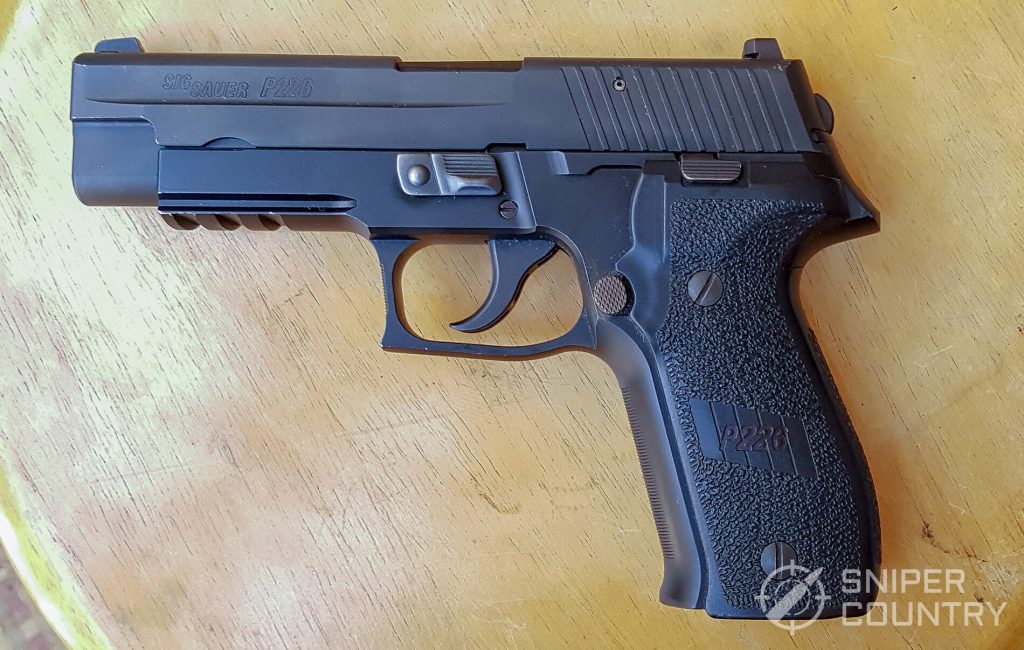
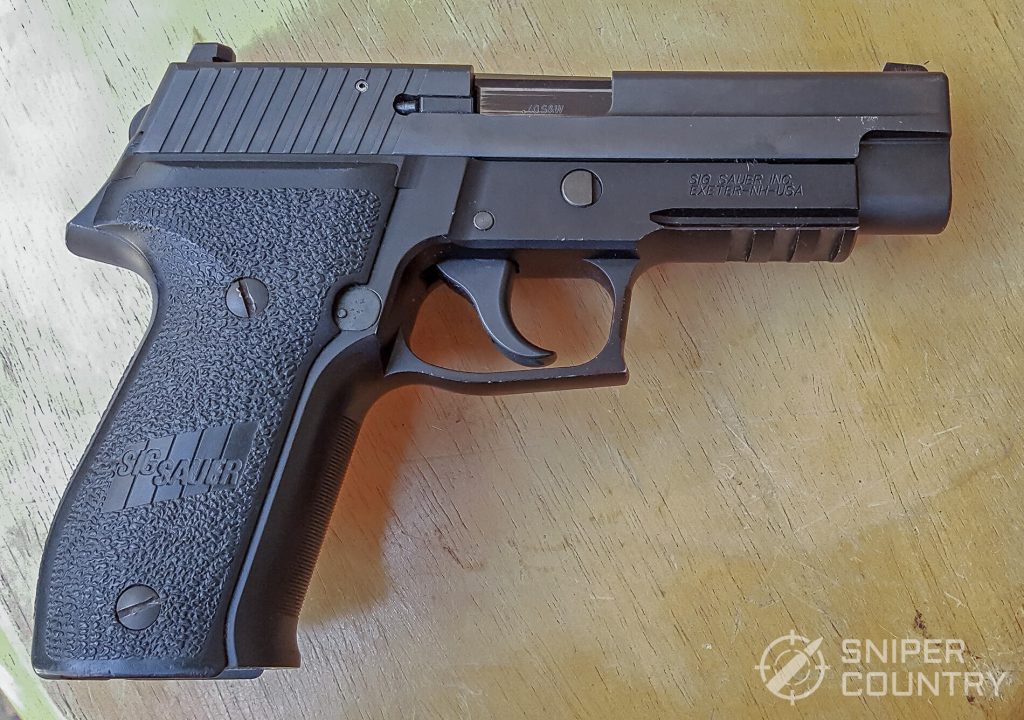
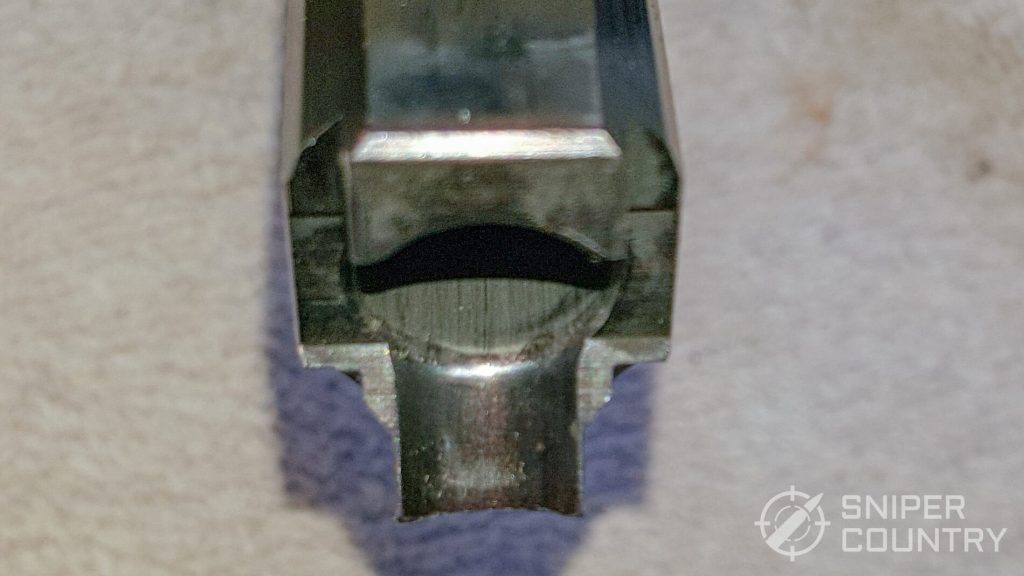
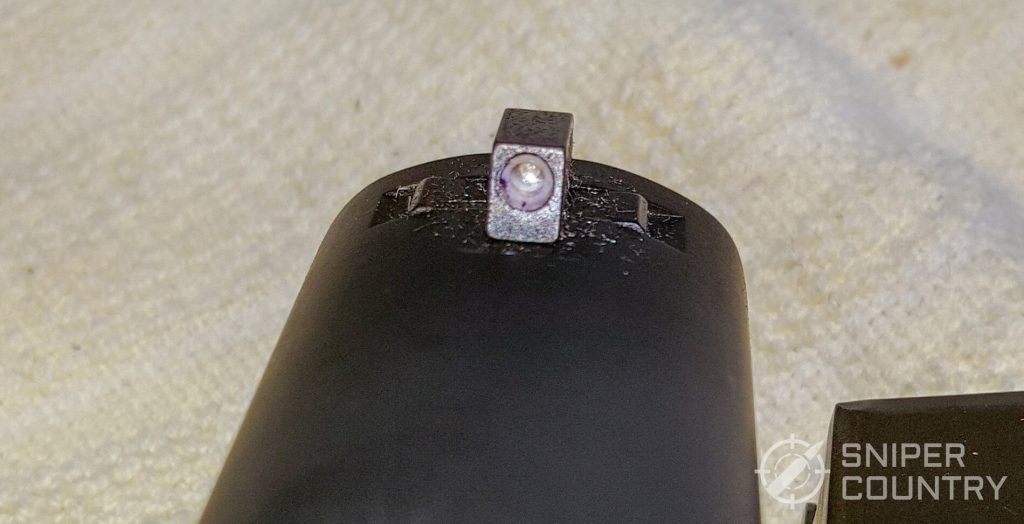
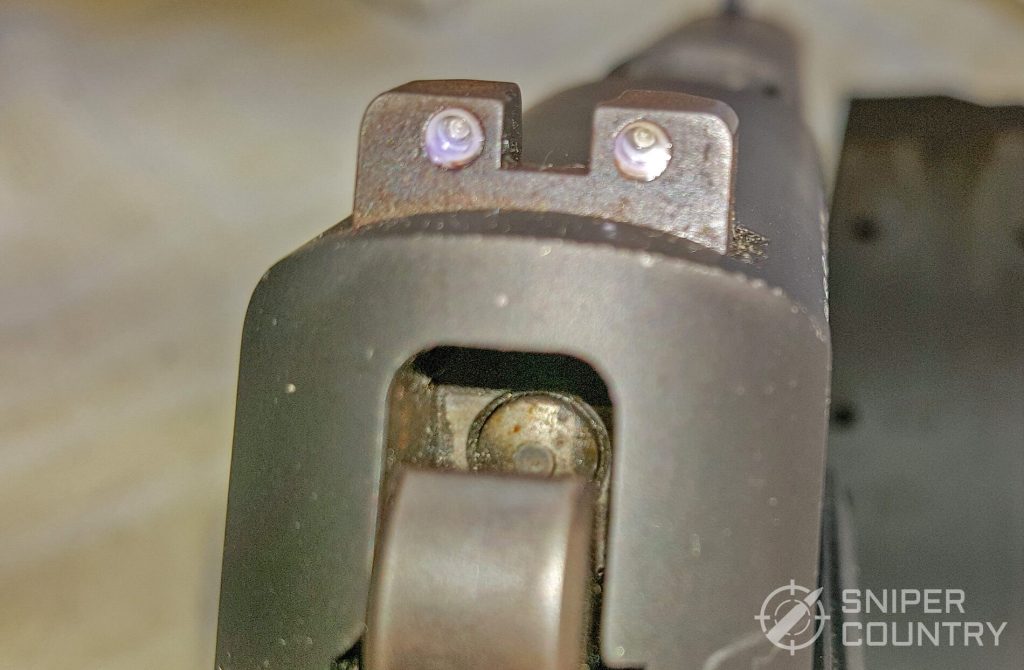
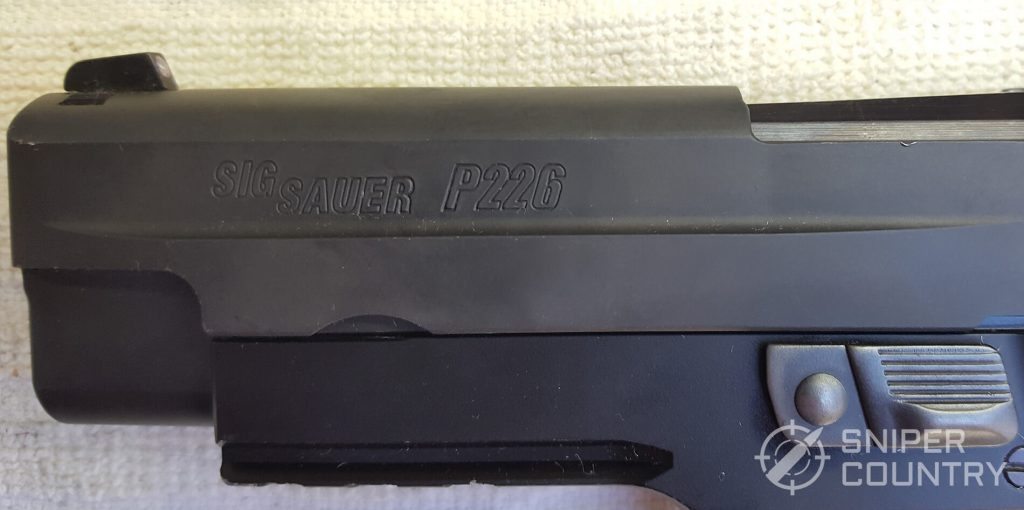
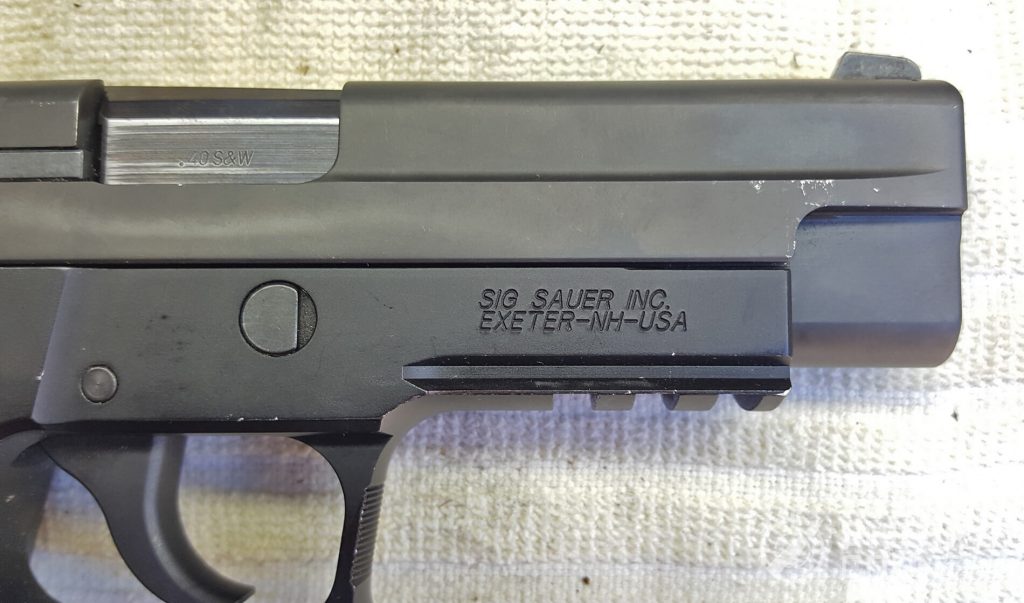
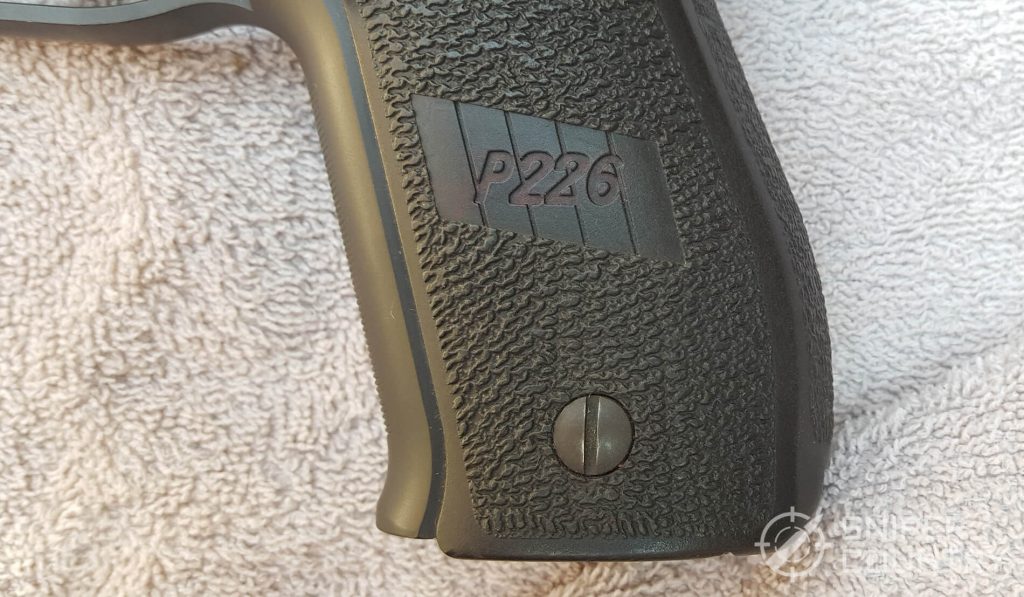
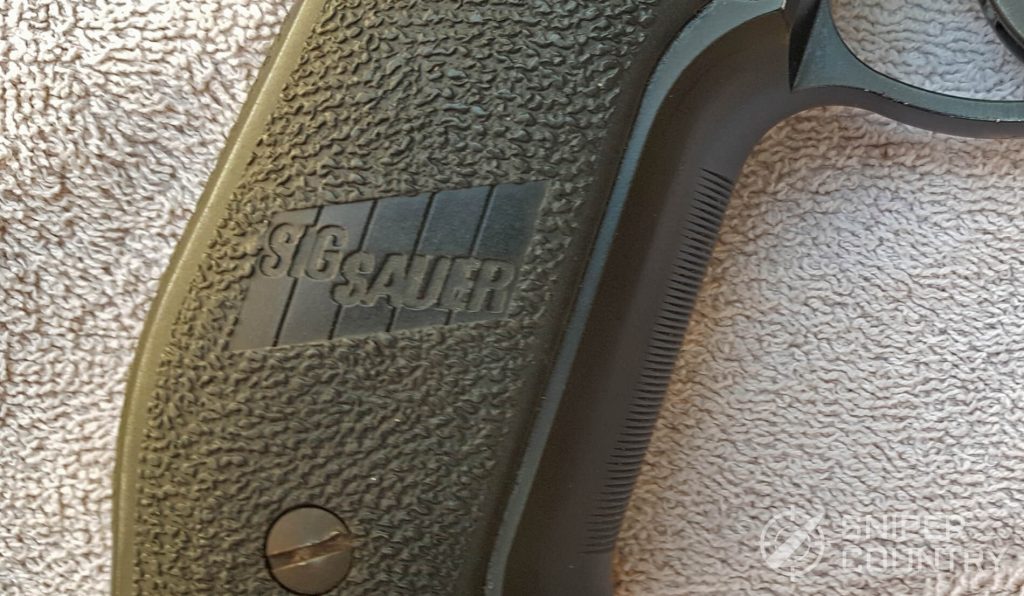

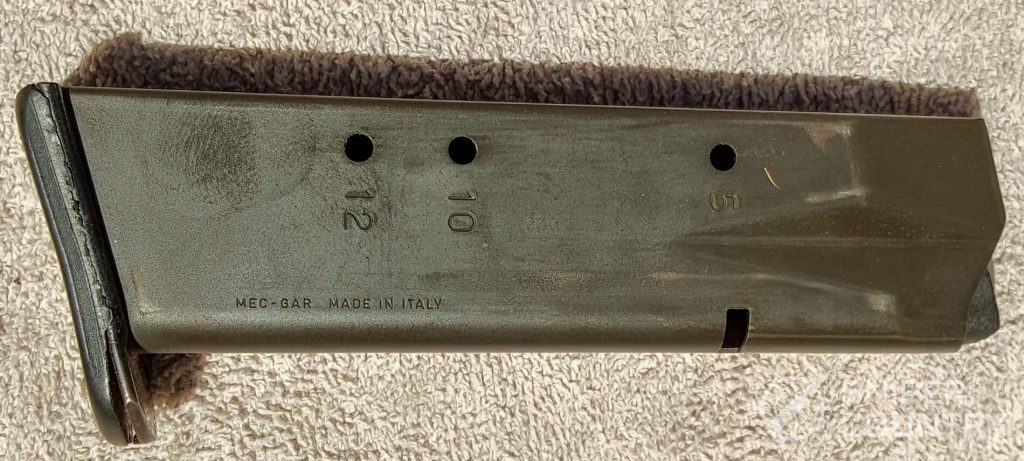
A Bit About The .40 S&W…
The P226 is chambered for a popular self-defense and law enforcement round, the .40 S&W. This cartridge was developed from a shortened 10mm and loaded to slightly lower pressures at the F.B.I.’s request. For a more in-depth description of the .40, please read my article on this round here. It is still a popular cartridge, although maybe not quite as popular as it once was. Even so, a good friend of mine just bought two .40 S&W M&P pistols, one for each of his cars, and my brother recently acquired an H&K P30 in .40 S&W. Add in the fact that most of the law enforcement agencies around where I live use the .40, so I guess it’s still alive and kicking. It’s even deer-legal in my state. You could sure do worse in terms of a self-defense or general-purpose round.
Shooting the P226
I really enjoyed shooting this gun. The stainless steel, Nitron-finished slide and the aluminum frame’s combined weight of 34 ounces really helped dampen the recoil of the .40, which can be a bit snappy.
I shot two different self-defense loads, a 155-grain Hydra Shok JHP from Federal and a 180-grain JHP load from Remington.
The loads chronographed as follows:
| Federal 155 Grain Hydra Shok JHP | 1130 f.p.s. | 439 f.p.e. | |
| Remington 180 Grain JHP | 997 f.p.s. | 397 f.p.e. |
Neither load was a barn-burner, but this wasn’t a 10mm, either…
Here is a representative target…
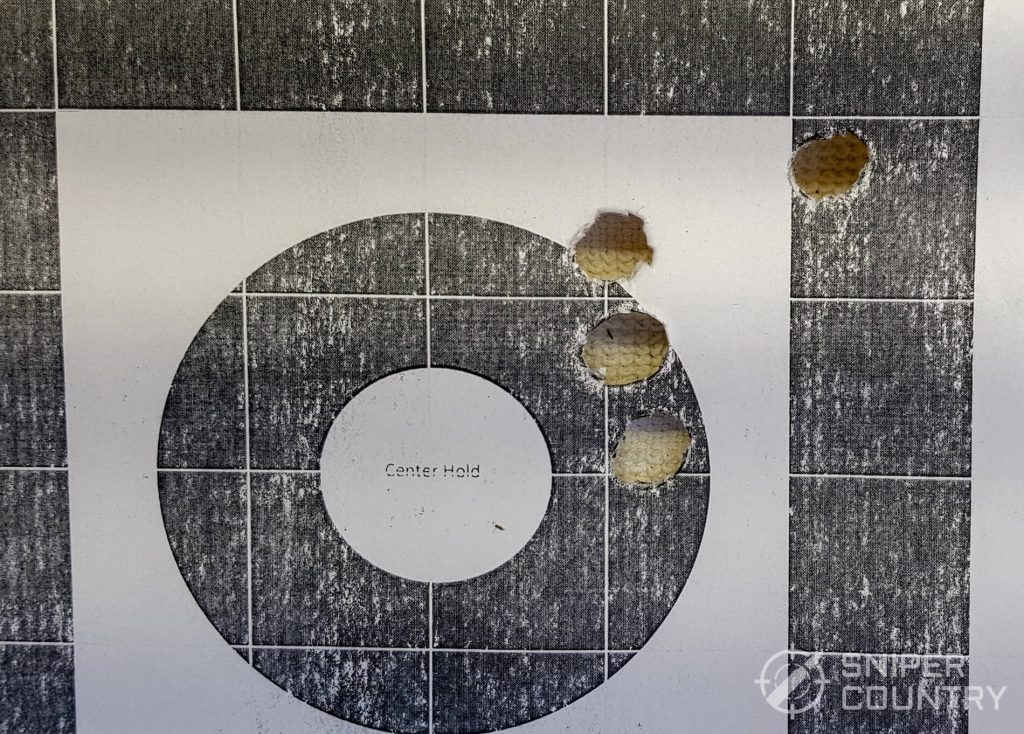
I did not try to get 25-yard-gilt-edged accuracy out the gun – I’d never shot it before – but just wanted to see how it felt. I had no troubles loading the magazine or charging the chamber – I’ve had some guns, especially 10mms, that had recoil springs so heavy that my arthritis-prone hands almost couldn’t rack the slide. Not here, though.
Here is a screen shot of a gel test of the Federal Ioad that I tested, from luckygunner.com. My Remington ammo was of an older vintage and I couldn’t find a gel test using their 180-grain JHP. The Remington load has been replaced by at least one newer version. The one I shot is their baseline JHP load, the ammo I had on hand. It is generally sold for a little less than the Golden Saber or HTP loads. You can look here for a terminal ballistics summary of the new incarnation of the 180-grain JHP load, as close to the load I shot as I can find. The point is that either load would suffice…I concentrated more on how the gun shot than the ballistics of the loads used.
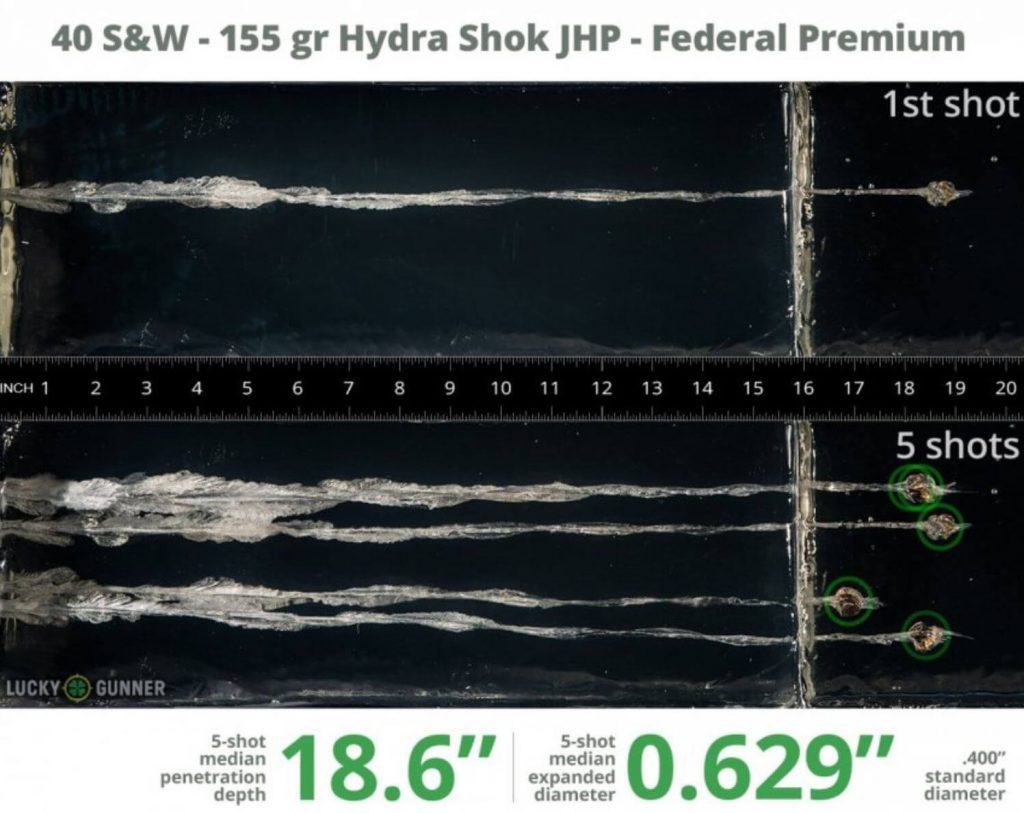
BONUS OFFER: Get your free shooting range targets to print at home!
Get your free targets to print at home!
Shooting Impressions and Takedown
Weight
When I first picked up the 226, I was taken by how solid it feels. This would not be out of the ordinary, given that it uses an aluminum frame and most other guns I’ve handled or shot recently used a polymer frame. The weight is listed at 34 ounces, which again is no surprise. The weight does help tame the recoil of the .40 – it can be a bit snappy, to use the currently popular buzz word for “kicks more than a little.â€
Grip
The grip panels were, to put it in a word, slick. Granted, this was a used gun (probably a LE trade-in once upon a time) and had been handled, if not shot, a lot. It did slide around in my hand a bit under recoil, but it wasn’t so bad that it required new sight acquisition with every shot. If it were mine, I’d probably stipple the grip panels or replace them. This is an option that most polymer-framed guns don’t offer – replaceable grip panels. I’m sure the aftermarket is chock full of different grips, sights, etc. for this gun. That would be an article in itself. Anyway, with a little “stickier†grip, it would settle down nicely. The only other thing worth mentioning about the grip is its circumference…large. I have medium-sized hands and had a bit of trouble placing my finger on the trigger in the preferred manner due to the reach involved. It’s not “Glock-ishâ€, but you can certainly tell you’re shooting a full-sized gun. One thing that did help was that the grip angle was better for me than that of a Glock. It was a natural pointer. (The old “close-your-eyes-raise-the-gun-then-see-if-you’re-on-target” pointability test worked every time). The gun is an inch and a half wide – it certainly lets you know you’ve gotten hold of a large, duty-type pistol when you grip the gun. I shot it just fine, but the size is worth mentioning for those of you with smaller hands.
Trigger
We’ve discussed the DAK system at length above, so the only thing I’ll mention about the trigger is that it was smooth, with an even pull, from either reset point. The 8-pound-pull from the rear reset point is just barely noticeably heavier than the full-forward 6.5-lb. point, not enough to really matter. I shot from both resets and couldn’t tell much difference. I think it would be easier to train SIG’s recommended way, from the full-forward 6.5-pound reset point. The other one would come in handy in the event of a trigger short-stroke, but I don’t believe I’d train to it.
Sights
The SIGLITE night sights on this gun have seen better days – the left rear sight lamp was dead. (Tritium sight lamps typically have a life of about 10 years – at least these sights are replaceable). That did not affect accuracy in the least. The sights are well-defined and easy to acquire in daylight. The dots were a little small for my aging eyes but were obtainable once I’d gotten used to them. The “working†right rear and front lamps glow pretty brightly – you could certainly line up your target easily enough at night with just those two dots. Another option would be the large-dot front irradiated XS-type sights that are offered by some makers…a large, “glowing†dot sitting on top of a similarly visible vertical post installed in the rear sight would make target acquisition fairly easy for older eyes. I definitely could see going with some type of night sights, as they do offer an advantage in dim lighting conditions.
Controls
The controls were easy to reach and operate. The slide release did not require a whole lot of pressure in order to let the slide go into battery, plus the size of the lever offered enough purchase for a good release every time. The sharply-checkered magazine release was the same – it did not take a lot of “push†to release the magazine. The Italian-made Mec Gar magazine dropped free of its own weight. The third control, the takedown lever, was very positive in its operation. All three of these levers or buttons were either checkered or had horizontal lines machined into them in order to avoid fingers slipping off them. All three control levers/buttons were above average in my opinion.
“Shootabilityâ€
OK…what does that mean, I hear you ask. By “shootabilityâ€, I am addressing the following questions:
- Is the gun easy to access from a holster;
- Is the gun easy to get on target;
- Is the gun easy to score hits with;
- Are accurate follow-up shots easily and quickly made?
- Is it easy to maintain?
If I had a numerical score that I gave each of those categories, it would be five out of five for all. Don’t forget that this is a full-size service pistol that holds rock-steady on target and allows fast follow-up shots. It sits well in a concealed carry holster and is easy to take apart to clean. Add in the unique DAK trigger and you have a winner. It’s no mystery why SIG sells so many of these and similar guns to police and military units.
Takedown
Takedown is very simple…lock the slide to the rear with the slide stop/release lever and rotate the takedown lever 90 degrees down. Release the slide and the slide comes right off without a trigger pull. From there, remove the recoil spring (not captive, but controllable – just keep a hand on it when you pull the assembly out of the slide). The barrel comes next. The drill is the same for most other autoloaders and is easily accomplished. If you notice in the photo above, the recoil spring is woven – three spring “strands†very tightly wound around each other in order to make one stronger spring. I’ve had issues putting some free-range recoil springs/guide rods back into their home under the barrel due to the strength of the spring. I think my hand strength limit is a spring of about 20-22 pounds – this one was no trouble. Even given the fact that the .40 is a higher-pressure round and would seem to require a fairly stiff spring, it went in with little effort. (I checked and found out that the factory spring is a 20-pounder). After the barrel and spring are in place, put the slide back on, sliding it over the (very long) rails. Lock it back with the slide stop/release and rotate the takedown lever up, release the slide and you’re back in action.
Conclusion
When I first picked the P226 up, I was taken by its solid feel – I think I mentioned that above, but it’s true. If ever you’ve picked a gun up and wondered if its construction would allow it to survive a box of ammo (let along survive for a few years), then you know what I mean. We’ve all handled guns that were, to be charitable, “iffy.†I’ve had guns come apart in my hand…that’s an experience you really don’t want to have. The SIG P226 definitely is not in that category. The aluminum frame and steel slide have a heft and a feel that just oozes quality construction. From the grip angle to the night sights, this is one gun that was made for keeps. Remember that it was SIG’s entry in the military handgun trials in 1984, so its build quality would have to be high. The gun is probably overbuilt (especially in the 9mm chambering) but that beefy construction sits well in your hand and holds steady on target. Even though I really didn’t shoot it for accuracy, there is no reason to think that the P226 would lack in that department.
If you are looking for a service-type pistol in .22 LR, 9mm, .40 S&W or .357 Sig, give the P226 or its compact cousin the P229 a look. I don’t think you’ll be disappointed. If you’ve had experience with this or other similar pistols, let us know in the comments below.

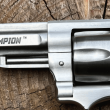



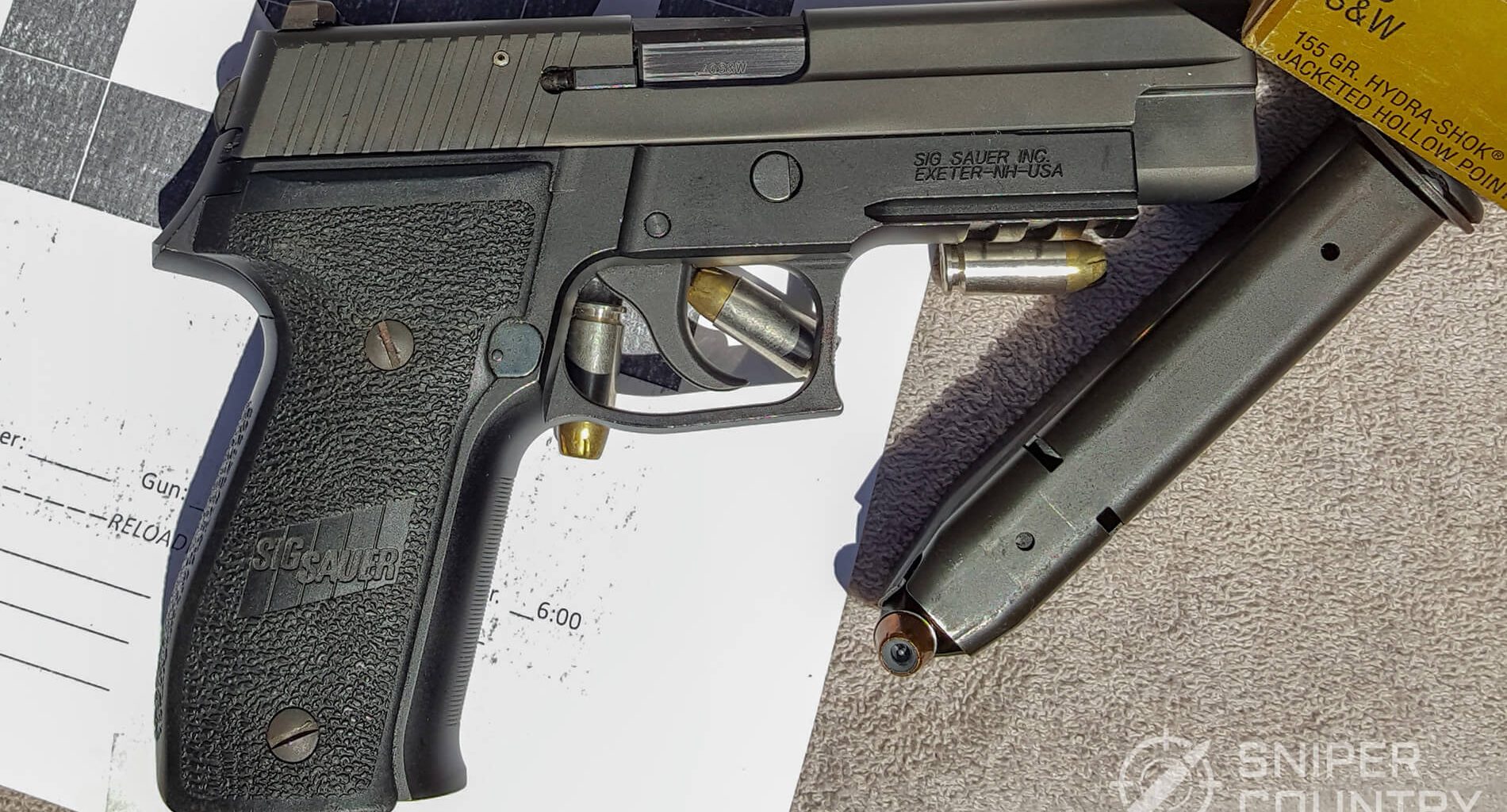
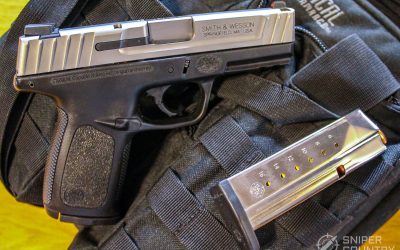

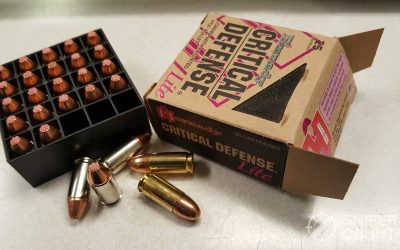
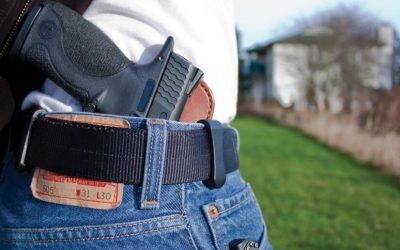
![9mm Glock Models [Ultimate Guide]](https://www.snipercountry.com/wp-content/uploads/2018/10/Glock-17-vs-Glock-19-vs-Glock-26-vs-Glock-41-vs-Glock-43-WM-400x250.jpg)
![Handgun Caliber Chart [2025 Ultimate Guide]](https://www.snipercountry.com/wp-content/uploads/2018/10/Handgun-Caliber-Comparison-400x250.jpg)
![Rifle Calibers [Ultimate Guide]](https://www.snipercountry.com/wp-content/uploads/2018/12/Header-1900-400x250.jpg)

